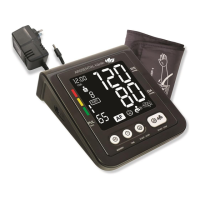
Do you have a question about the Airssential Home LifeLine Kardio AI-K118A and is the answer not in the manual?
| Type | Upper Arm Blood Pressure Monitor |
|---|---|
| Technology | Oscillometric |
| Measurement Range (Pressure) | 0-299 mmHg |
| Accuracy (Pressure) | ±3 mmHg |
| Cuff Size | 22-42 cm |
| Power Source | 4 x AA batteries or AC adapter |
| Connectivity | Bluetooth |
| Measurement Range (Pulse Rate) | 40-180 bpm |
| Features | Irregular heartbeat detection, WHO classification indicator |
| Display | LCD |
| Accuracy (Pulse Rate) | ±5% |
Defines the device's purpose and suitability for adult self-monitoring of blood pressure.
Provides critical safety guidelines and precautions for accurate and safe blood pressure self-measurement.
Advises on avoiding strong electromagnetic fields to prevent interference with measurement accuracy.
Explains the physiological basis of blood pressure and its measurement.
Details normal, high, and low blood pressure ranges and recommends consulting a doctor.
Identifies the main components and buttons of the blood pressure monitor unit.
Instructions for checking the contents of the package and reporting missing or damaged items.
Guidance on inserting batteries, battery warnings, and notes on battery handling and replacement.
Information on operating the monitor with the provided AC adapter and its specifications.
Explains how to select or switch between the two user memory zones for personalized readings.
Step-by-step guide to correctly set the current time and date on the monitor.
Advises on pre-measurement routines like avoiding exertion and resting in a quiet environment.
Lists factors that can cause inaccurate blood pressure readings and how to avoid them.
Detailed instructions on correctly attaching the blood pressure cuff to the arm for accurate measurements.
Guides through the single measurement process, including cuff inflation, detection, and result display.
Illustrates typical measurement results with explanations for IHB, cuff fit, and movement detection.
Explains the two-measurement mode for detecting Atrial Fibrillation (AFIB) and its benefits for reliability.
Instructions on how to stop a measurement in progress and release cuff pressure.
Explains how to permanently clear all stored measurement data from the monitor's memory.
Provides solutions for common malfunctions such as display issues or inaccurate readings.
Guidelines for protecting the monitor from environmental factors and handling components safely.
Instructions for cleaning the monitor and cuff, and avoiding chemical cleaners.
Information on how to properly dispose of the device and its accessories as electrical waste.
Explains the meaning of various symbols found throughout the instruction manual.
Details the monitor's electromagnetic emission compliance according to the IEC60601-1-2 standard.
Details the monitor's electromagnetic immunity compliance according to the IEC60601-1-2 standard.
Provides guidance on minimum separation distances for RF communication equipment to prevent interference.
